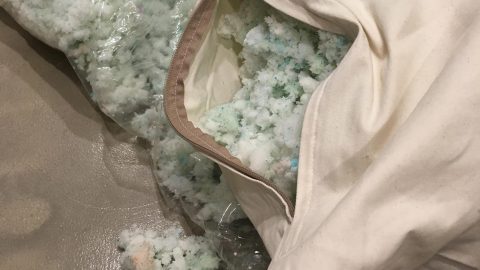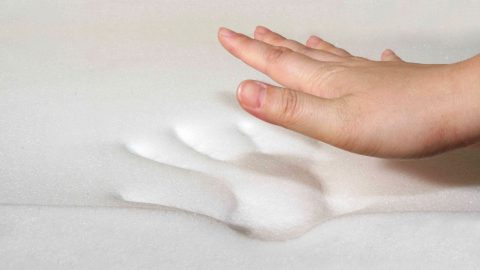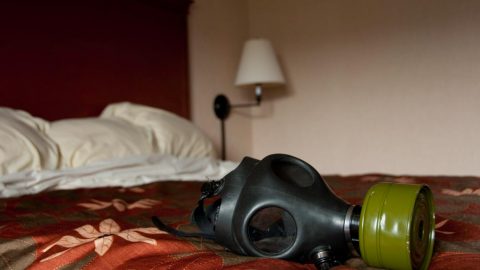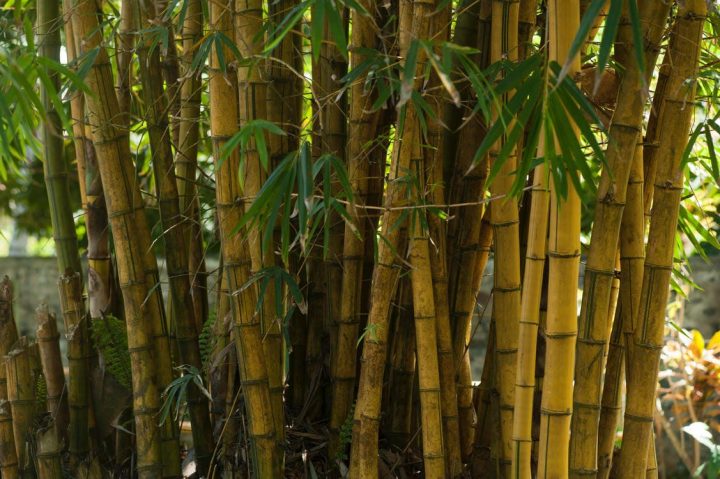 The fantastic bamboo pillow is everywhere. They’ve recently exploded in popularity. According to Google Trends, they’re even more popular than traditional down pillows! People seem to like them: the reviews are generally positive.
The fantastic bamboo pillow is everywhere. They’ve recently exploded in popularity. According to Google Trends, they’re even more popular than traditional down pillows! People seem to like them: the reviews are generally positive.
Despite their prevalence, I only noticed them recently. They caught my attention for one reason: bamboo pillows appear to be a “green” product.
I try to shop responsibly, purchasing products that are ecologically responsible when possible. A pillow made from the bamboo plant, a plentiful renewable resource, seemed like an environmentally friendly and safe product for a tree-hugger like myself.
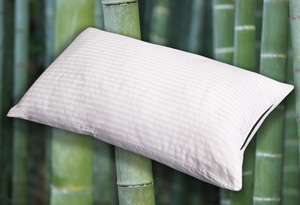
Don’t be fooled, hippy! This thing’s got zero green cred.
What is a bamboo pillow?
The name clearly implies that a primary component must be bamboo. As it turns out, the majority are filled with shredded memory foam, a petroleum-based product. The fabric outer shell or case, is most commonly a blend of rayon and polyester.
So where’s the bamboo? The truth is in the fine print: apparently the case’s rayon fabric is derived from bamboo.
Yes, bamboo pillows are essentially just a memory foam pillow with a rayon pillow case.
According to popular product descriptions, these magical bamboo pillows are:
- environmentally friendly
- hypoallergenic
- antimicrobial
- biodegradable
- cooler than traditional pillows
- adjustable
- supportive and moldable

Future generations will call this idyllic place, “Shredded Memory Foam Falls”
Are bamboo pillows environmentally friendly?
Bamboo sounds like a responsible and safe component to use in a pillow. Marketers love to use the word bamboo in their product descriptions, because it appeals to eco-conscious consumers like me. Unfortunately, manufacturing bamboo fabric, i.e., rayon, is not harmless to the environment.
The most common way to produce rayon involves the “viscose” process.
A strong chemical bath dissolves the cellulose material derived from bamboo. Then it is treated with toxic chemicals like carbon disulphide, caustic soda, ammonia, acetone and sulphuric acid until it solidifies into useable fibers. Production releases hazardous air pollutants. In addition, 50% of the solvents used are dumped as wastewater.
Rayon isn’t the only pollutant used in the production of these pillows.
Manufacturing memory foam and polyester both result in the release of carcinogenic materials into our air and water causing significant environmental damage. It’s unclear if there are adverse health issues associated with long-term exposure to the chemicals contained in memory foam.
Verdict: You won’t find a bamboo pillow on mother nature’s bed.
It’s misleading to suggest that viscose rayon, polyester and memory foam are environmentally-friendly materials, particularly when compared to traditional all-natural fabrics and fill types.
Are bamboo pillows hypoallergenic?
Hypoallergenic claims resonate with consumers and help to sell products. What exactly is implied? Unfortunately it is very vague because there is no regulation in the United States that defines or governs the use of the term. Blakiston’s Medical Dictionary, however, defines it:
“Hypoallergenic” – Adjective
A term applied to a preparation in which every possible care has been taken in formulation and production to ensure minimum instance of allergic reactions.
Are the makers of these pillows taking “every possible care” in the creation of their hypoallergenic products?
First, let’s consider the bamboo pillow’s primary component, memory foam. A quick search of “memory foam allergy” reveals substantial and credible user complaints. Headaches, rashes and similar allergic-type reactions are all documented issues.
No credible evidence exists that suggests that memory foam is less likely to cause allergic reactions than other pillow fill types.
As it happens, dust mites are the true allergy menace and no pillow type is immune to them.
Dust mites are tiny organisms that live in the dust in your house and are one of the top five most common allergens. If you’re experiencing an allergic reaction to a pillow that you’ve been using for awhile, chances are you’re allergic to dust mites, not the pillow itself.
Dust mite allergies are very similar to a pollen allergy except that the symptoms occur year round instead of just seasonally. All bedding is susceptible to dust mite infestations, including the so-called bamboo pillow.
Verdict: To call bamboo pillows hypoallergenic is misleading.
Saying that these pillows are hypoallergenic is, at best, an overstatement. Additionally, a lack of regulation and oversight makes the term hypoallergenic somewhat meaningless.
Are bamboo pillows antimicrobial?
Bamboo is unique in that it contains a substance called bamboo-kun. This antimicrobial agent gives bamboo a natural resistance to pest and fungi infestation. Unfortunately, the chemical processes used to produce rayon destroys any of bamboo’s antimicrobial properties. There is no trace of the original bamboo plant’s resistance to bacteria in the finished rayon product.
Verdict: A bamboo pillow is not antimicrobial.
Are bamboo pillows biodegradable?
Biodegradable materials can break down into natural materials without causing harm to the environment. Memory foam and polyester are not biodegradable. Depending on the specific types used, these materials will sit around for hundreds of years in the landfill. Rayon, is 90% biodegradable, but it is a very small portion of the pillow’s total mass.
Verdict: A bamboo pillow is not biodegradable.
In most bamboo pillows, only a small percentage of the fabric pillow case is truly biodegradable.

A breathable pillow is a cool pillow.
Are bamboo pillows cool?
If air is able to circulate through a pillow’s fill, it’ll stay cool while you sleep. Unfortunately, memory foam does not have a reputation for being breathable. It restricts airflow, causing the pillow to build up and retain body heat. I’ve tried several different types of memory foam pillows over the years and none could be described as being “cool.”
Most bamboo pillows, however, contain “shredded” memory foam. Manufacturers simply tear this shredded fill into little pieces from memory foam. These individual pieces allow for better air circulation though the pillow vs a traditional solid piece of memory foam. However, for some reason, many of the available bamboo pillows are enclosed in a foam enclosure or case (this is in addition to the rayon/poly outer fabric case) that restricts airflow. This negates much of the cooling ability gained from using shredded vs. traditional memory foam.
Well, maybe the rayon/polyester blend, err “bamboo” fabric is extra breathable? It’s not more breathable than traditional bedding fabrics like linen or cotton that are well-known for their breathability.
Verdict: They aren’t any cooler than traditional pillows.
A bamboo pillow is no better at keeping you cool than a traditional pillow filled with down or similar fill. Memory foam’s reputation for retaining heat certainly doesn’t suggest that it’s superior.
The U.S. government has taken action against some sellers of bamboo pillows.
There have been attempts by the government to deal with the issue of deceptive marketing of bamboo products. For example, several large retailers were warned in 2009 by the FTC about the blatantly misleading bamboo claims. It didn’t end with warnings…
“Sears Holdings agreed to pay $475,000 and remove false advertising from its line of “100% pure bamboo” products, which were anything but. Sears was the first of several large companies, including Amazon.com and Macy’s, that agreed to pay fines totaling nearly $1.3 million for violating for violating the Textile Products Identification Act…” –Time Magazine
The settlements set a precedence and larger retailers are mostly adhering to the FTC’s guidance. However, the deceptive marketing practices remain prevalent amongst smaller retailers. At the time of writing, several Amazon sellers are making “100% bamboo” claims.
Because of these actions, most reputable sellers today no longer allege that these pillows are 100% bamboo. Even without that simple falsity, most bamboo pillow benefits are grossly overstated.
Bamboo pillow benefits are exaggerated, but they’re not all bad…
The shredded memory foam contained in most bamboo pillows is impressive. If you’ve ever felt it, you know what I mean. It has a magical sort of texture that uniquely conforms to pressure. Memory foam has the viscous properties of water, but the elastic feel of traditional poly foams. These unique characteristics make memory foam pillows very popular.
If you rest your head on one, the memory foam will compresses and conform perfectly to the shape of your body. When you release the pressure on the pillow, the memory foam slowly resets and changes back to its original shape.
This makes memory foam effective at evenly distributing your body’s weight, eliminating pressure points.
Memory foam is quite good at providing support for your head and neck. It evenly cradles the weight of your head eliminating any pain-causing pressure points, allowing your muscles and joints to completely relax. The fact that many bamboo pillows are adjustable via a zippered opening is a big plus. This allows you to fine tune your pillow’s loft (thickness) to your personal preferences.
I’ve tried a shredded memory foam pillow myself. (without a rayon, err bamboo… pillow case).
It impressed me. My shredded memory foam pillow was far superior to all the traditional one-piece memory foam pillows I’d tried before.
Despite the comfort, the off-gassing odor was a constant annoying reminder of the potential health and environmental associated with memory foam. For that reason, my shredded memory foam pillow didn’t win a permanent place on my bed.
Try an alternative with real green credentials.
If you’ve considered purchasing a bamboo pillow based upon their supposed green image, ignore the hype. Many popular pillow filling alternatives are safe, both for us and the environment:
As for a pillow’s fabric case, we recommend cotton. It’s the overwhelming favorite for use in bedding products for a reason… It’s soft, breathable and cheap to manufacture. Unfortunately, like rayon and other types of fabric, the production of cotton often releases toxic chemicals into the environment. For this reason, we encourage consumers to purchase certified organic cotton bedding manufactured to OEKO-TEX standards.
Have you ever slept on a buckwheat pillow?
They’re sort of like a bean bag for your head. A buckwheat pillow’s unique filling allows it to conform perfectly to the shape of your head and neck while keeping you comfortable and cool all night long.
We manufacture our product, Hullo, responsibly. We only use the best organic and all natural materials that are biodegradable. They’re safe for both your family and the environment.
Give Hullo a try. Discover what true sleep is really like! Don’t take my word for it, check out our customer’s reviews:
“First buckwheat pillow, will never go back to anything else. Searched far and wide for a replacement to my toxic memory foam pillow, and was curious and willing to try anything to help my neck support, especially as a side sleeper. Pillow arrived, perfect condition, and I have yet to remove any of the original filling (you can adjust the volume of the pillow by adding and subtracting more buckwheat hulls). Took about 1 night to understand how to get comfortable, and now most other pillows feel broken. Believe the hype, and protect your family with better products in your home. Start with a Hullo pillow, you won’t regret it!” – Hullo customer, C. Conners

